2013 Pcx 150 Specs
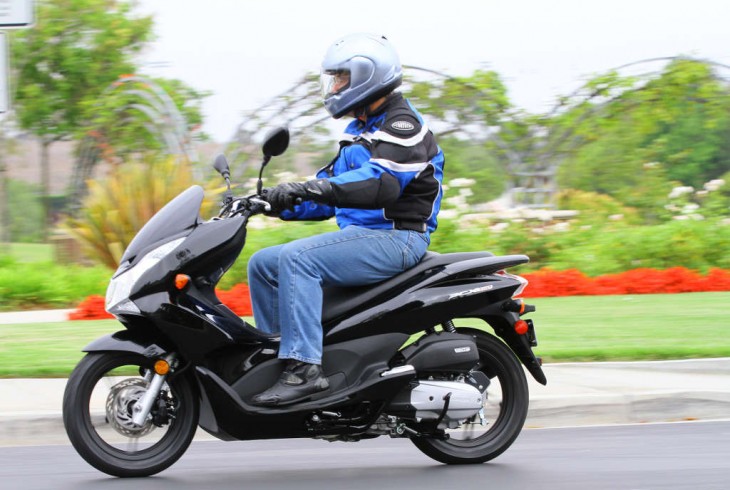
Can you test a ZX-14R and then jump on a 150cc (153cc, actually) scooter and still have fun? Still be impressed? Yes and yes, if that scooter is Honda's new PCX150.
Of course the PCX150 isn't about mind bending acceleration and 9 second quarter miles. It is fun because it feels light and nimble, has an incredibly low CG, and has enough power to put a pal or significant other on the back.
Sort of like a Weight Watchers dessert, that enjoyment comes without the guilt. A claimed (and believable) 102 mpg, and an MSRP of just $3,449.00. Fill your 1.6 gallon fuel tank for $5.00, and have the power to hop on the freeway and cruise at 65mph. You could say this is the right vehicle at the right time for lots of buyers.
For 2013, Honda took the PCX125 that impressed Gabe, and gave it the extra oomph to provide genuine freeway, and 2-up capability. Oh, and they even improved its fuel efficiency in the process.
The list of engine improvements is quite long, actually.
- An offset cylinder reduces friction caused by contact between the piston and cylinder wall.
- Piston weight has been reduced through the use of CAE analysis (Computer Aided Engineering).
- The cylinder sleeve uses minute spines on its outer surface to reduce oil consumption and improve cooling.
- A shell-type needle bearing is used for the rocker arm shaft; reducing friction.
- Small lightweight rollers work in conjunction with an optimized cam profile and valve spring load.
- The radiator core is approximately 1.5 times more efficient, allowing the use of a smaller, lighter cooling fan, reducing frictional losses by 30%.
- Internal modifications lower oil agitation losses, and transmission oil capacity has been reduced by approximately 25.
- Frictional losses in the transmission unit have been reduced by approximately 20% (at 50kmh), due to the use of bearings exclusively designed to deal with the loads they individually receive.
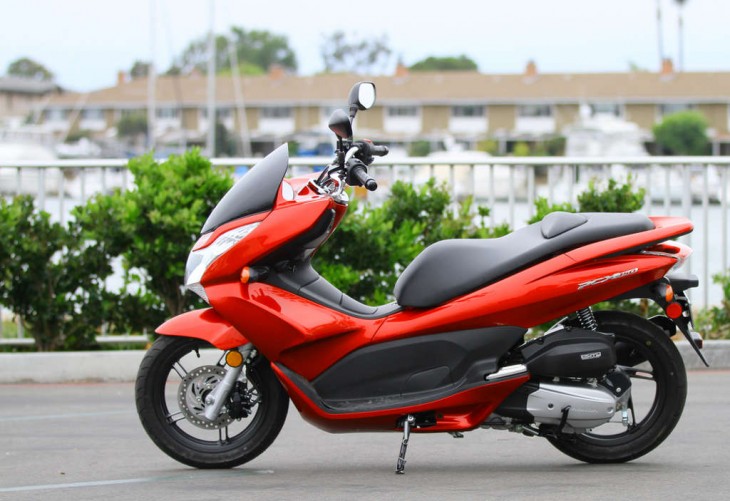
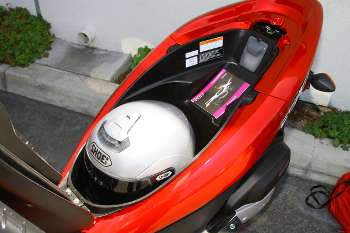
The new, larger engine is lighter and smaller overall, which reduces the unsprung weight controlled by the rear suspension. Honda also claims to have improved seat comfort this year with a redesigned cushion and backrest.
In addition to the ample underseat storage that swallowed my large, full-face Arai (just barely), the PCX150 features a glove box in the dash, and will soon have the option of fitting a 35-liter top box (currently in development). You can also store a helmet by a hook and loop, which is locked in place by the seat.
Previous to this test, the smallest displacement scooter I have personally ridden is a 250cc single-cylinder Vespa. The Vespa is a nice machine, but I actually felt the 153cc Honda engine pulled at least as well as the Vespa despite the displacement disadvantage. The Honda pulls impressively off the bottom, as I discovered when my friend Barry Winfield and I took off on two of the PCX150s to split traffic on California's Pacific Coast Highway. We frequently pulled up to red lights between two cars, and blasted away from them when the light turned green. Something you take for granted on a larger motorcycle, but impressive on a scooter of this size.
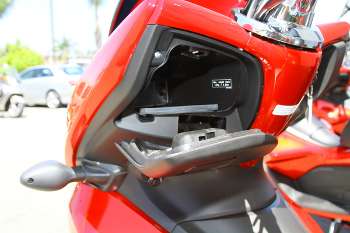
We even took the PCX150 on the freeway, where it comfortably maintained 65 mph, and appeared to have a top speed in the low-to-mid 70s. Of course, a strong headwind or hill will reduce the top speed of any small displacement scooter, and the PCX150 is no different.
The 14" wheels are a big improvement, in my opinion, compared to the 12" wheels found on some other small scooters. Bumps are smoothed out considerably, and the handling is much more stable at higher speeds. The little PCX felt rock steady on the freeway, for instance.
At the same time, the narrow tires and low center of gravity make the PCX150 extremely nimble, yet still able to confidently hold its line on fast, sweeping turns. Again, impressive for this category.
The engine performance and excellent CVT transmission combined to allow two-up riding without seeming to be much of a strain on the drivetrain. I sampled a 130 pound female passenger, as well as a 6'1", 200 pound male (putting us at roughly 400 pounds, total). With the 130 pound passenger, I felt very little additional engine strain. I could even see taking a smaller passenger on the freeway without too much trouble. The 200 pound passenger was more obviously felt, but the bike was still surprisingly quick off the bottom. The non-adjustable rear suspension, with a progressively wound spring, also held up surprisingly well under the additional load.
The ergonomics were comfortable, and wind protection was reasonable. Shorter riders will have no trouble standing flat-footed at stop lights, and even Barry (6'5") did not look comically large as he rode next to me.
Suspension performance was very good, as well. The rear suspension, in particular, impressed me. It is relatively firm, but smooth at the same time.
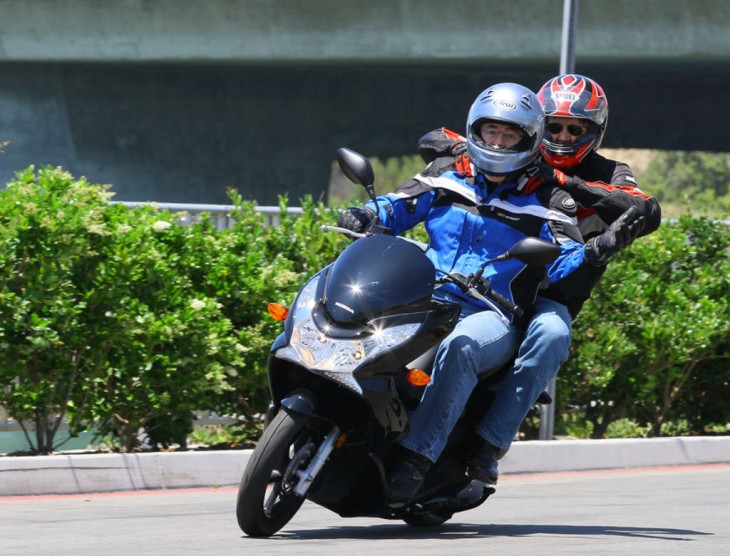
My 200 pound passenger told me the passenger accommodations were pretty comfortable, so I don't know why he wanted to strangle me.
The front disc and rear drum brake are plenty strong and offer decent feel. Use of the rear brake will combine automatically with application of the front brake while the front brake lever is not linked.
Instrumentation is pretty basic, but very legible and includes a fuel gauge (which never seemed to move during the test).
A welcome feature is the inclusion of both a center stand and a side stand.
About the only thing I could criticize after our initial ride would be a hard seat that felt comfortable on shorter trips, but might be a bit uncomfortable on longer rides. Of course, the focus of this bike is not long distance touring, rather shorter trips with the convenience of being both freeway legal and two-up capable. With a very competitive price point ($3,449.00), Honda appears to have hit the sweet spot with the PCX150. It is hard to see a category of rider that couldn't find interest in this excellent mid-sized scooter. If you are concerned about the environment (and your wallet), it could appeal to riders of all skill and experience levels as a second bike. Anyone interested in fun, economical and practical motoring would be a logical candidate as well. The PCX150 feels light and easy to handle, so brand new riders and females also fit the profile. Who knows, this might even be one of the machines that gets disinterested Gen Z members on to two wheels.
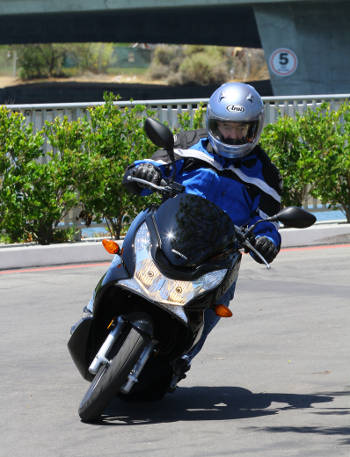
2013 SPECIFICATIONS
Model: PCX150
Engine Type: 152.9cc liquid-cooled single-cylinder four-stroke
Bore and Stroke: 58.0mm x 57.9mm
Compression ratio: 10.6:1
Valve Train: SOHC; two-valve
Induction: PGM-FI with automatic enrichment
Ignition: Digital with electronic advance
Transmission: Honda V-Matic belt-converter automatic transmission
Suspension
Front: 31mm hydraulic fork; 3.5 inches travel
Rear: Twin shock; 3.1 inches travel
Brakes
Front: Single 220mm disc with three-piston caliper
Rear: Drum with CBS
Tires
Front: 90/90-14
Rear: 100/90-14
Wheelbase: 51.8 inches
Rake (Caster Angle): 27.0°
Trail: 86mm (3.4 inches)
Seat Height: 29.9 inches
Fuel Capacity: 1.6 gallons
Estimated Fuel Economy: 102 MPG
Colors: Candy Red, Metallic Black
Curb Weight*: 286 pounds
*Includes all standard equipment, required fluids and full tank of fuel—ready to ride.
Honda's fuel-economy estimates are based on EPA exhaust emission measurement test procedures and are intended for comparison purposes only. Your actual mileage will vary depending on how you ride; how you maintain your vehicle; weather; road conditions; tire pressure; installation of accessories; cargo, rider and passenger weight; and other factors.
Meets current CARB and EPA emissions standards.
You can follow any responses to this entry through the RSS 2.0 feed. Both comments and pings are currently closed.
Source: https://www.motorcycledaily.com/2012/07/2013-honda-pcx150-md-first-ride/

0 Komentar